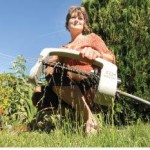Summerland’s water system, as well as several more within the Kelowna area, entered stage two of water restrictions earlier than usual and all corners of the Okanagan are on alert due to inflow levels that are sitting at some of the lowest marks on record.
“Since we began measurements on Okanagan Lake in 1918, this is the sixth lowest inflow,” said Alan Chapman of the B.C. Ministry of Environment’s River Forecast Centre.
Inflow is the amount of water that streams into the lake during the spring when the snowpack melts. This year’s trickle is similar to that of 2003, and ultimately means that Okanagan Lake isn’t being fed its normal amount of H2O, leaving it a couple centimetres below average.
While low lake levels are a cause for concern, Chapman said it’s not yet the worst case scenario, which was seen during the great North American droughts of the ‘30s.
“The Okanagan Valley is a very arid area, and it’s dry at the best of times,” he said. “Typical annual precipitation in the Okanagan Valley, varies from 300 millimetres in the south to 600 millimetres in the north — it’s one of the dryer parts of the province.”
He added that basin-reliant communities have been gearing up for the current state since the beginning of the year, and the onset of a few days of rain could help the situation out immensely.
However, the weather forecast is calling for hot and dry conditions continuing through the middle of next week.
That said, the Okanagan Basin Water Board is readying itself and the communities it represents for drier conditions.
“I think individuals need to be more aware of what’s going on around them. What we’re in now is not an emergency, but it’s a time of concern because the lake levels are quite low” explained Anna Warwick Sears, the executive director of the board.
“We haven’t had that much rain or snowpack this year, so it’s good for people to think about how they can cut back their water use.”
To get a jump on water conservancy, the board is holding a drought response planning meeting that all Okanagan water purveyors are asked to attend. Those who do will glean information on the current water situation and learn some tools available for utilities to respond to water shortages and to prepare for future drought conditions.
“It’s way overdue,” said Warwick-Sears, of the workshop. “I guess it depends on your philosophy whether to have a drought response workshop when you’re in emergency, or when you are being proactive — having it now is splitting the difference.”
The board is also in the process of completing an assessment on what the water supply in the basin as a whole looks like.
The water supply and demand project, which will be completed in December, is a detailed study on how all the different communities are interconnected with their water supply. In addition to sussing out what the demands are, they’ll also be working with climate change scientists from Environment Canada, to find out what this area’s residents can expect in the future.
“First we are looking at how many water licences we have in the basin and relating those to how much is actually being used, and we’re looking at how much supply is coming in,” said Warwick Sears. “Then we’re looking at how the supply will be challenged by climate change, and how the demand will change with climate change.”
With global warming comes longer summers, which means people will be irrigating their lawns or agricultural land more. It also means there will be further evaporation.
“We are looking at having less water come in and more water leave,” Warwick Sears said.
While many forces beyond local control are at play, Warwick Sears said she doesn’t believe that the future is less than rosy.
“ I am a great believer in our adaptive ability,” she said. “Here in the Okanagan we use more than twice as much water than they use in Australia per capita. So there’s no reason why we couldn’t effectively double our water supply by reducing our water use.”
The board’s drought response planning event takes place at the Kelowna Community Theatre July 23. Contact the OBWB for more information as space is limited.

